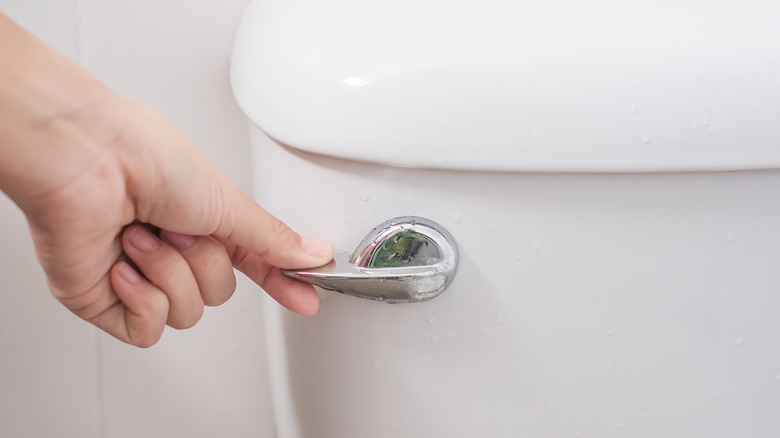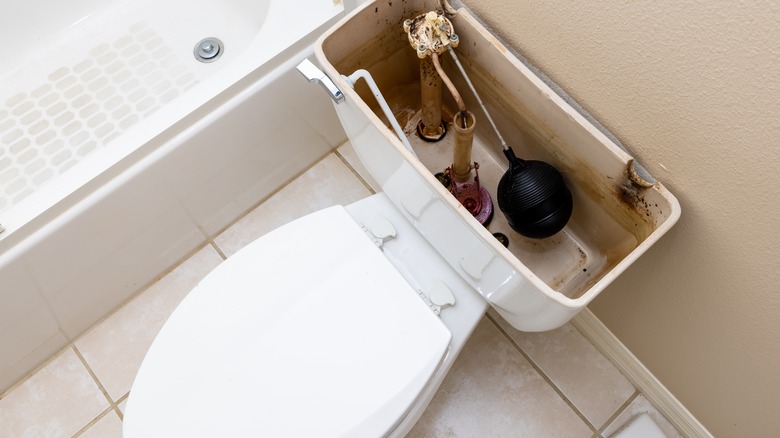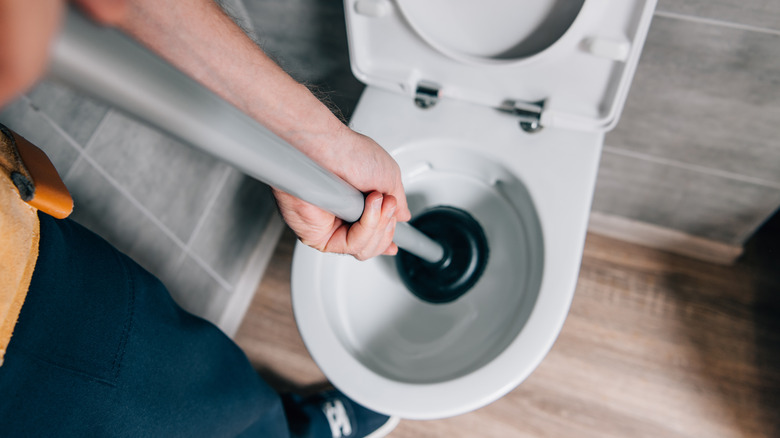If You're Always Having To Flush Your Toilet Twice, This Is Likely Why
Few things are as frustrating as a toilet that won't flush correctly. Nobody enjoys those extra few minutes spent in the bathroom waiting to flush a second time — especially not your guests. There are a few reasons why your toilet could be struggling to flush. It may have worn-out parts that need replacing or mineral buildup that requires clearing. However, it's also possible that you may be dealing with a bigger problem, such as a poorly designed toilet that should be removed altogether and replaced with something more efficient.
Whatever the reason may be, this is one of the most common toilet problems you shouldn't turn a blind eye to. A weak flush could signify a leak or a clog that will only get worse with time. Plus, all of those extra flushes increase your home's water usage to boot. So, in an effort to save money on your water bill and avoid bigger, more expensive plumbing jobs down the line, let's investigate the cause of your faulty flush and what you can do to fix it.
Common reasons why your toilet may not be flushing properly
If you've noticed that your toilet doesn't flush as well as it used to, there could be several underlying causes. Fortunately, most of them likely stem from one main issue, which is that your toilet bowl is not receiving enough water to get everything down the drain with a single flush. Likewise, a weak flush could also be a sign of a toilet with worn-out parts, a low-quality toilet, or possibly even a clog. Low-flush toilets are great in theory, since they use significantly less water per flush than regular toilets. However, if you're running into this issue with your low-flow toilet, chances are you are dealing with a low-quality loo and will likely need to replace it. Not all water-saving toilets are created equally, and some are more poorly designed than others.
Always ensure that your appliances come from reputable manufacturers to avoid running into problems down the line. Elsewhere, regular toilets that do not flush all the way on the first try may have an issue with the flapper valve, which is the part that's responsible for keeping water in the tank. An old flapper could have cracks in it, which causes the water to leak into the bowl and drain from the tank, contributing to a weaker flush. If none of these appear to be the case for your toilet, you may have a hard water buildup issue or a clog in the pipes.
How to fix your poorly-draining toilet and prevent future issues
Repairing a faulty toilet on your own is not always easy. Calling a professional is the best way to ensure that your issue gets resolved properly and quickly. However, if you feel confident in your plumbing abilities, there are several things you can do to fix a weak flush. An old or broken flapper can be replaced in a few simple steps. Shut off the water supply, position the tank ball over the flush valve, unhook the flapper and remove the chain. When installing the replacement flapper, ensure that the chain is not too tight as this will keep it open and lead to flushing issues all over again. Likewise, a clogged drain can sometimes be fixed relatively easily with a plunger or by dumping water directly into the bowl.
Meanwhile, mineral buildup may dissolve by treating it with acidic substances such as vinegar and lemon juice, or products that hard water deposits. However, if these DIY solutions do not fix your problem, it's crucial that you get an expert to take a look ASAP before the issue becomes insurmountable. To prevent future problems, there are plenty of maintenance tips that will keep your toilet in tip-top shape. These include checking the water levels in your toilet tank regularly and preventing clogs by being aware of what is safe to flush. Most importantly, don't let issues go unresolved, as this could cause them to worsen in the future.


